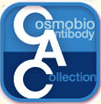 CAC Antibody Collection
CAC Antibody Collection
The antibodies on this page are part of Cosmo Bio's exclusive CAC Collection. For many many thousands of other antibodies from many different makers, use our Search the Store function and our Explore Products drop down menu.
Hedgehog pathway
The Hedgehog signaling pathway is a signaling pathway that transmits information to embryonic cells required for proper cell differentiation. Different parts of the embryo have different concentrations of hedgehog signaling proteins. The pathway also has roles in the adult. Diseases associated with the malfunction of this pathway include basal cell carcinoma. The Hedgehog signaling pathway is one of the key regulators of animal development and is present in all bilaterians. The pathway takes its name from its polypeptide ligand, an intercellular signaling molecule called Hedgehog (Hh) found in fruit flies of the genus Drosophila; fruit fly larva lacking the Hh gene are said to resemble hedgehogs. Hh is one of Drosophila's segment polarity gene products, involved in establishing the basis of the fly body plan. Larvae without Hh, are short and spiny, resembling the hedgehog animal. The molecule remains important during later stages of embryogenesis and metamorphosis. Mammals have three Hedgehog homologues, Desert (DHH), Indian (IHH), and Sonic (SHH), of which Sonic is the best studied. The pathway is equally important during vertebrate embryonic development and is therefore of interest in evolutionary developmental biology. In knockout mice lacking components of the pathway, the brain, skeleton, musculature, gastrointestinal tract and lungs fail to develop correctly. Recent studies point to the role of Hedgehog signaling in regulating adult stem cells involved in maintenance and regeneration of adult tissues. The pathway has also been implicated in the development of some cancers. Drugs that specifically target Hedgehog signaling to fight this disease are being actively developed by a number of pharmaceutical companies. [from: Wikipedia contributors. (2019, May 10). Hedgehog signaling pathway. In Wikipedia, The Free Encyclopedia. Retrieved 19:29, June 3, 2019, from https://en.wikipedia.org/w/index.php?title=Hedgehog_signaling_pathway&oldid=896462864]References:
1) Ellis R WB, van Creveld S. (1940) A syndrome characterized by ectodermal dysplasia, polydactyly, chondro-dysplasia and congenital morbus cordis: report of three cases. Arch. Dis. Child. 15:65-84.
2) Ruiz-Perez V L, et al. (2000) Mutations in a new gene in Ellis-van Creveld syndrome and Weyers acrodental dysostosis. Nat. Genet. 24:283-286.3) Tsuji, T. et al. (2004) Expression of Ellis-van Creveld (Evc) gene in the rat tibial growth plate. Anatomical Record. 279A:729-723.
| Product name (click for order info) | Cat No (click for datasheet) |
Host | Species specificity |
| Anti Ellis-van Creveld Syndrome Protein Homolog (EVC) pAb (Rabbit, Antiserum) | CAC-OUA-P01-A | RAB | RT MS |
| Product name | Anti Ellis-van Creveld Syndrome Protein Homolog (EVC) pAb (Rabbit, Antiserum) |
| Cat No | CAC-OUA-P01-A |
| Description | EVC is a gene associated with Ellis-van Creveld syndrome. It overlaps with the CRMP1 gene. EVC is one of two genes (the other being EVC2) that upon mutation give rise to EvC (Ellis-van Creveld) syndrome in humans and is found to act as a positive mediator for three hedgehog (Hh) signaling molecules. Mice with an inactivation of the EVC gene (EVC -/-) were found to exhibit similar physical characteristics as humans, such as shortened limbs and dental impairments. In a study of 65 individuals affected with EvC, mutations in the EVC gene were found in 20 of them, and primarily attributed to a frameshift resulting in a nonsense codon. More mild physical characteristics not completely associated with EvC syndrome, such as those without the expected oral deformities can also be attributed to EVC gene mutations. [from: Wikipedia contributors. (2019, May 3). EVC (gene). In Wikipedia, The Free Encyclopedia. Retrieved 19:37, June 3, 2019, from https://en.wikipedia.org/w/index.php?title=EVC_(gene)&oldid=895336273] |
| Host | RAB |
| Species specificity | RT MS |
